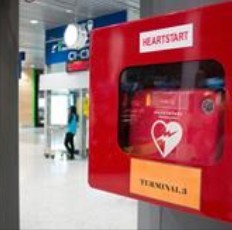ACCESS is a research study that aims to determine the best method of care for patients resuscitated after an out-of-hospital ventricular fibrillation (V-Fib) cardiac arrest, but who have no EKG evidence of a heart attack.
What is Ventricular Fibrillation (V-FIB)
V-fib occurs if disorganized electrical signals make the heart ventricles quiver instead of pump normally. Without the ventricles pumping blood to the body, such as during V-fib, sudden cardiac arrest and death can occur within a few minutes
EKGS and Myocardial Infarctions
An Electrocardiogram (EKG or ECG) shows the electrical function of the heart. The heart pumps blood to the body because electricity in the heart muscles causes the heart to contract. Doctors can use EKGs to tell how much of the heart muscle wall is damaged during a Myocardial Infarction (or Heart Attack). EKG tracings showing ST-Elevation Myocardial Infarction (STEMI) heart attacks tell doctors that an artery in the heart is blocked.
It becomes harder to decide what to do next when the EKG does not show a STEMI or Non-ST-elevation myocardial infarction. In those cases, doctors may suspect, but can’t be sure whether there is a blockage in the artery.
Who will be included?
- Adults presumed or known to be 18- 75 years old
- Resuscitated from out-of-hospital-cardiac- arrest, (have a heart beat in the Emergency Department [ED])
- Initial cardiac arrest rhythm of pulseless VT or VF (Ventricular Tachycardia)
- No ST-segment elevation MI on ED 12- lead EKG as interpreted by a physician
Why participate in this study?
Some experts believe patients with No-STEMI (maybe up to 30%) may have a blockage of some sort. If so, immediate cardiac catheterization may be helpful in restoring heart activity. Other experts prefer to stabilize the patients in the Intensive Care Unit (ICU) and then decide later if the patient should go to the catheterization lab in some cases.
What are the risks and benefits?
Because we do not know which treatment is best for people with these types of heart attacks, a person enrolled in the study may receive a better treatment method. Based on the information we get from this study, people who have No-STEMI after a VT/VF in the future may benefit from what is learned in this study.
Risks common to both treatments are infection, damage to the liver, damage to the heart with low blood pressure, damage to multiple organs in the body, seizures, repeated cardiac arrest, survival to hospital discharge with decreased function, and death. Risks associated with catheterization are heart attack (caused by the catheterization), stroke (caused by the catheterization), injury to the catheterized artery, tear in the heart or heart artery, fluid or blood around the heart, bleeding requiring blood transfusion, kidney damage (caused by contrast dye), and death (as a direct complication of catheterization). The risks of these complications generally occur less than 1 out of 100 times.
How is ACCESS different than other studies?
Due to the short treatment window, we will have to act within the first 45 minutes following ED arrival. We will try to get in-person contact with a legally authorized representative and have a formal informed consent discussion.
If that is not possible, we will try telephone contact with patient representatives to ask about general objections to enrollment in any research. If there is no family contact within the first 45 minutes; the patient will be treated in the trial under EFIC.
What is EFIC?
The U.S. Department of Health and Human Services (DHHS) is a federal agency that oversees human research protection. The FDA and DHHS have created a set of special rules, called “Waiver/ Exception from Informed Consent” (EFIC). These special rules allow research studies in certain emergency situations to be conducted without consent. Before researchers may do a study using EFIC, they must provide information about the study to the community and get their feedback.
How can I share my opinion?
Before the study starts, meetings will be held in the community to provide information, answer questions and get community members’ thoughts and feelings about the study. You can call the study team to complete a one-on-one interview about the study. There will also be information about the study in the media.
How can I be excluded from the study?
There are two methods for opting out:
- Through a Medic Alert™ membership.If you have an existing medic alert tag or bracelet you can add “ACCESS Study Declined” to it. If you have a medic alert membership you can add “ACCESS Study declined” to your Emergency Medical Information Record. If you would like to find out more information about your existing medic alert services or for a new membership visit: www.medicalert.org
- Call us to request an Opt Out bracelet be sent to you to wear with the words “ACCESS declined”. You will need to wear this bracelet at all times during the study period (approx.5 years), or else you could be enrolled.
If you do not participate in the study, you will receive the standard medical treatment provided for resuscitated cardiac arrest patients at the hospital in your community.


